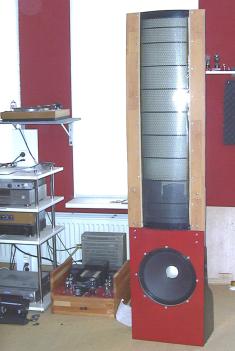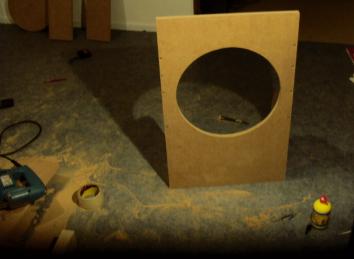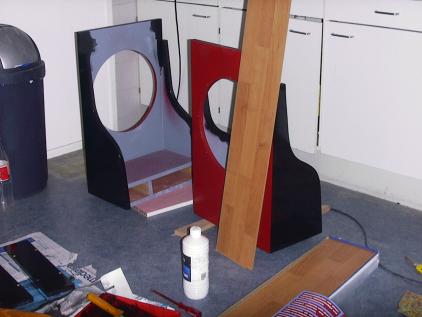last update: Oct 07, 2002
 When the first Chiron speaker was finished, I solomly swore I'd never build a speaker again. I am a circuit man, not a
woodworker. I hate it, I don't have the skills and the tools for it, nor the patience for the tedious work involved.
When the first Chiron speaker was finished, I solomly swore I'd never build a speaker again. I am a circuit man, not a
woodworker. I hate it, I don't have the skills and the tools for it, nor the patience for the tedious work involved.
However, all good things must come to an end... as much as I enjoyed the Chiron speakers their weak point was the bass reproduction. The bass-reflex enclosure did not perform as well as the TQWT enclosure of the speakers I owned before. I recently got a pair of Altec 421-8H woofers and was thinking of using these in such an enclosure, but that would mean it'd have to be absolutely huge. Furthermore, while the ESL is a dipole, the woofer is an omnipole and that creates acoustic difficulties. At the listener's position, everything was adjusted to sound optimal. But as a result of that, off-axis the bass was louder than the rest. In the adjacent room big oomphs were heard at the bass reflex and room width mode frequencies. The only way around was to build a dipolar woofer system.
Dipoles have advantages and disadvantages. The most obvious disadvantage is the acoustic short circuit they see in the horizontal plane because of the cancellation of front- and backwave that occurs there. This goes at the cost of efficiency. However, in this directionality also lies their great advantage: they have no susceptibility to horizontal room modi and that means twice as few room interactions!
In a quest for more knowledge on the subject, I landed on Siegfried Linkwitz's dipolar woofer model page. This is www on its best: a simple explanation without voodoo or magic. Go and read the entire site. In a few simple steps, Linkwitz explains the steps to go from a boxed omnipole design to an open-baffle dipole design. It then hit me. Of course! An open baffle is intrinsically the same as a H-shaped design. Wow. The accompanying math is astonishingly simple and the most important conclusions are:
- A dipole loses 6 dB per octave down due to the wavelength increasing w.r.t. the distance between the antiphase point sources (the baffle diameter). This must be compensated for in the crossover (Yaay, J-Lo!).
- The frequency at which the output is equal to an omnipole is Feq = v / 6*D .
- At lambda = D/2, a +6 dB boost occurs since the front and back wave are acoustically in phase.
- A baffle with a non-constant D smears the above phenomena over different frequencies.
These are all the ingredients you need to create an open-baffle loudspeaker. I decided I could live with an Feq of 250 Hz. At this frequency, the ESL takes over from the woofer. The tradeoff is the 6 dB loss per octave, which meant that at 31.25 Hz I'd have to provide 18 dB of extra gain. Not that that's a big issue, amplification is inexpensive these days and the Altec has a much higher sensitivity than the Vifa I was using until now (in fact, in the end I have the filters at lower amplitude than before!). It's the limited Xmax of the speaker that might create a problem. However, if you do the math you'll find that this won't occur until I'm playing at SPL levels that will cause my skull to crash before the membrane will. 15 inches of diameter create a huge area...
 With the above considerations a tidal wave of enthusiasm was caused. I decided to ride that wave before my motivation would
dry up and so I immediately went out and got wood, screws, paint and started work. In a few lost hours, I drew up the
dimensions:
With the above considerations a tidal wave of enthusiasm was caused. I decided to ride that wave before my motivation would
dry up and so I immediately went out and got wood, screws, paint and started work. In a few lost hours, I drew up the
dimensions:
In this design, the baffle size was tapered. With Feq at 250 Hz, D=22 cm is already enough. With a 15" woofer such as the
Altec, you only need 3 cm of wood on both sides. Wow! At the smallest point on the baffle, I'm now at 28 cm. Smaller was
impossible since some structural integrity was also required.
The ESL is placed on the woofer's baffle so that their acoustic centers are aligned. In this fashion, the ESL becomes part of
the woofer baffle and thus helps boost its LF response. That apparent coincidence is pure poetry for an engineer. If you draw the effective baffle length
against aperture phi of the woofer, you see that baffle resonances are evenly spread and response is lifted from 34 Hz
upwards. While drawing, it occured to me that placing the speaker on the ground would boost the LF response even further,
since front and backwave can't meet underneath the speaker. Great! So much for buying expensive spikes. Now the response is
boosted from 23 Hz upward. It gets better and better...
 The total design looks as if it was drawn up by a baboon, that's how simple it is. It's an educated simplicity though. In that paradoxality lies a charm.
I liked this design from the moment I dreamt it up. So, I overcame my dislikes and started woodworking. Had to do it all
myself, I didn't dare ask my friend who did such a splendid job the last time since I declared his lifetime achievement,
Chiron I already obsolete again...
The total design looks as if it was drawn up by a baboon, that's how simple it is. It's an educated simplicity though. In that paradoxality lies a charm.
I liked this design from the moment I dreamt it up. So, I overcame my dislikes and started woodworking. Had to do it all
myself, I didn't dare ask my friend who did such a splendid job the last time since I declared his lifetime achievement,
Chiron I already obsolete again...
sanding.
 priming.
priming.
sanding.
painting.
sanding.
spraypainting.
sanding...
and spraypainting...
and sanding again...
grr.
The enclosure combines the bass baffle, a frame for the panels (detachable, might you want to take it to Arhus ;-), separate room for ESL HV powersupply, and some room to fill with lead, sand or an amplifier (who knows...?) The rear panel is detachable again, I call it a 'service panel'. It turned out really helpful in Chiron I, I can't recall how many times I've opened that speaker up to change something.
This is not a small change.
I am usually very reluctant to describe 'massive' changes, since many are just a wee step forward. But this... this is a landslide. Deep bass, deeper than I had even hoped or dreamt, but that's not the most important. The most important are the clarity and control. Others call it speed, not to be mistaken with the inverse of woofer frequency range, so I won't use that term. There is simply less energy lingering around in both driver assembly and enclosure. So no more 'after-transient-decaying'. A bass drum hit dies out fast, and that makes music totally different. Bass lines in songs I never heard before are now clear. Pianos hitting low notes have size and naturalness. Classical music becomes enjoyable!
Many don't realize that the human ear experiences frequency in a logarithmic fashion instead of a linear one, and hence the
importance of a controlled and even, coherent LF response. That logarithmic sensitivity is why the octave
was initially invented! You clearly notice that e.g. when you use a spectrum analyzer. If you don't put the frequency axis
in logarithmic mode, all the phenomena you hear are at the far left side of the picture.
In this respect, 250 Hz is a very good turnover point for a 2-way speaker. The woofer really does nearly half of the perceived
frequency range.
W.r.t. Chiron I, off-axis the frequency balance has been bettered, everywhere in the room bass and highs are in harmony. In the next room, there are no more
booms. Mission accomplished!
Nodge-nodge... ;-)))